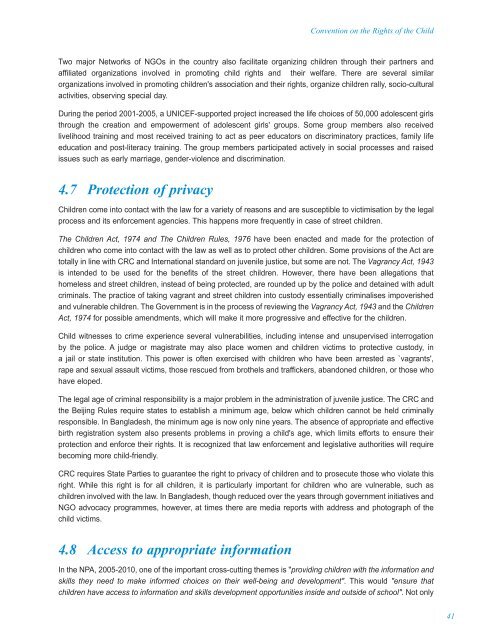Third and Fourth Periodic Report on CRC - Unicef
Third and Fourth Periodic Report on CRC - Unicef
Third and Fourth Periodic Report on CRC - Unicef
You also want an ePaper? Increase the reach of your titles
YUMPU automatically turns print PDFs into web optimized ePapers that Google loves.
C<strong>on</strong>venti<strong>on</strong> <strong>on</strong> the Rights of the Child<br />
Two major Networks of NGOs in the country also facilitate organizing children through their partners <str<strong>on</strong>g>and</str<strong>on</strong>g><br />
affiliated organizati<strong>on</strong>s involved in promoting child rights <str<strong>on</strong>g>and</str<strong>on</strong>g> their welfare. There are several similar<br />
organizati<strong>on</strong>s involved in promoting children's associati<strong>on</strong> <str<strong>on</strong>g>and</str<strong>on</strong>g> their rights, organize children rally, socio-cultural<br />
activities, observing special day.<br />
During the period 2001-2005, a UNICEF-supported project increased the life choices of 50,000 adolescent girls<br />
through the creati<strong>on</strong> <str<strong>on</strong>g>and</str<strong>on</strong>g> empowerment of adolescent girls' groups. Some group members also received<br />
livelihood training <str<strong>on</strong>g>and</str<strong>on</strong>g> most received training to act as peer educators <strong>on</strong> discriminatory practices, family life<br />
educati<strong>on</strong> <str<strong>on</strong>g>and</str<strong>on</strong>g> post-literacy training. The group members participated actively in social processes <str<strong>on</strong>g>and</str<strong>on</strong>g> raised<br />
issues such as early marriage, gender-violence <str<strong>on</strong>g>and</str<strong>on</strong>g> discriminati<strong>on</strong>.<br />
4.7 Protecti<strong>on</strong> of privacy<br />
Children come into c<strong>on</strong>tact with the law for a variety of reas<strong>on</strong>s <str<strong>on</strong>g>and</str<strong>on</strong>g> are susceptible to victimisati<strong>on</strong> by the legal<br />
process <str<strong>on</strong>g>and</str<strong>on</strong>g> its enforcement agencies. This happens more frequently in case of street children.<br />
The Children Act, 1974 <str<strong>on</strong>g>and</str<strong>on</strong>g> The Children Rules, 1976 have been enacted <str<strong>on</strong>g>and</str<strong>on</strong>g> made for the protecti<strong>on</strong> of<br />
children who come into c<strong>on</strong>tact with the law as well as to protect other children. Some provisi<strong>on</strong>s of the Act are<br />
totally in line with <strong>CRC</strong> <str<strong>on</strong>g>and</str<strong>on</strong>g> Internati<strong>on</strong>al st<str<strong>on</strong>g>and</str<strong>on</strong>g>ard <strong>on</strong> juvenile justice, but some are not. The Vagrancy Act, 1943<br />
is intended to be used for the benefits of the street children. However, there have been allegati<strong>on</strong>s that<br />
homeless <str<strong>on</strong>g>and</str<strong>on</strong>g> street children, instead of being protected, are rounded up by the police <str<strong>on</strong>g>and</str<strong>on</strong>g> detained with adult<br />
criminals. The practice of taking vagrant <str<strong>on</strong>g>and</str<strong>on</strong>g> street children into custody essentially criminalises impoverished<br />
<str<strong>on</strong>g>and</str<strong>on</strong>g> vulnerable children. The Government is in the process of reviewing the Vagrancy Act, 1943 <str<strong>on</strong>g>and</str<strong>on</strong>g> the Children<br />
Act, 1974 for possible amendments, which will make it more progressive <str<strong>on</strong>g>and</str<strong>on</strong>g> effective for the children.<br />
Child witnesses to crime experience several vulnerabilities, including intense <str<strong>on</strong>g>and</str<strong>on</strong>g> unsupervised interrogati<strong>on</strong><br />
by the police. A judge or magistrate may also place women <str<strong>on</strong>g>and</str<strong>on</strong>g> children victims to protective custody, in<br />
a jail or state instituti<strong>on</strong>. This power is often exercised with children who have been arrested as `vagrants',<br />
rape <str<strong>on</strong>g>and</str<strong>on</strong>g> sexual assault victims, those rescued from brothels <str<strong>on</strong>g>and</str<strong>on</strong>g> traffickers, ab<str<strong>on</strong>g>and</str<strong>on</strong>g><strong>on</strong>ed children, or those who<br />
have eloped.<br />
The legal age of criminal resp<strong>on</strong>sibility is a major problem in the administrati<strong>on</strong> of juvenile justice. The <strong>CRC</strong> <str<strong>on</strong>g>and</str<strong>on</strong>g><br />
the Beijing Rules require states to establish a minimum age, below which children cannot be held criminally<br />
resp<strong>on</strong>sible. In Bangladesh, the minimum age is now <strong>on</strong>ly nine years. The absence of appropriate <str<strong>on</strong>g>and</str<strong>on</strong>g> effective<br />
birth registrati<strong>on</strong> system also presents problems in proving a child's age, which limits efforts to ensure their<br />
protecti<strong>on</strong> <str<strong>on</strong>g>and</str<strong>on</strong>g> enforce their rights. It is recognized that law enforcement <str<strong>on</strong>g>and</str<strong>on</strong>g> legislative authorities will require<br />
becoming more child-friendly.<br />
<strong>CRC</strong> requires State Parties to guarantee the right to privacy of children <str<strong>on</strong>g>and</str<strong>on</strong>g> to prosecute those who violate this<br />
right. While this right is for all children, it is particularly important for children who are vulnerable, such as<br />
children involved with the law. In Bangladesh, though reduced over the years through government initiatives <str<strong>on</strong>g>and</str<strong>on</strong>g><br />
NGO advocacy programmes, however, at times there are media reports with address <str<strong>on</strong>g>and</str<strong>on</strong>g> photograph of the<br />
child victims.<br />
4.8 Access to appropriate informati<strong>on</strong><br />
In the NPA, 2005-2010, <strong>on</strong>e of the important cross-cutting themes is "providing children with the informati<strong>on</strong> <str<strong>on</strong>g>and</str<strong>on</strong>g><br />
skills they need to make informed choices <strong>on</strong> their well-being <str<strong>on</strong>g>and</str<strong>on</strong>g> development". This would "ensure that<br />
children have access to informati<strong>on</strong> <str<strong>on</strong>g>and</str<strong>on</strong>g> skills development opportunities inside <str<strong>on</strong>g>and</str<strong>on</strong>g> outside of school". Not <strong>on</strong>ly<br />
41
















